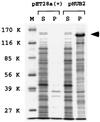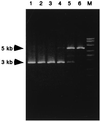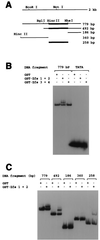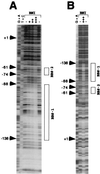Basonuclin, a zinc finger protein of keratinocytes and reproductive germ cells, binds to the rRNA gene promoter
- PMID: 10449744
- PMCID: PMC22260
- DOI: 10.1073/pnas.96.17.9628
Basonuclin, a zinc finger protein of keratinocytes and reproductive germ cells, binds to the rRNA gene promoter
Abstract
Basonuclin is a protein containing three pairs of C(2)H(2) zinc fingers. The protein has been found in the basal (germinal) cell layer of stratified squamous epithelia, such as the epidermis, and in germ cells of the testis and ovary. We show here that the human protein has specific affinity for a segment of the promoter of the gene for rRNA. Basonuclin interacts with two separate parts of the promoter, each possessing dyad symmetry. The upstream part, but not the downstream part, is known to bind UBF1, a transcription factor for rDNA. Basonuclin is likely to be a cell-type-specific regulatory protein for rDNA transcription.
Figures






Similar articles
-
Basonuclin is associated with the ribosomal RNA genes on human keratinocyte mitotic chromosomes.J Cell Sci. 1999 Sep;112 Pt 18:3039-47. doi: 10.1242/jcs.112.18.3039. J Cell Sci. 1999. PMID: 10462520
-
Translocation of the zinc finger protein basonuclin from the mouse germ cell nucleus to the midpiece of the spermatozoon during spermiogenesis.Biol Reprod. 1998 Aug;59(2):388-94. doi: 10.1095/biolreprod59.2.388. Biol Reprod. 1998. PMID: 9687312
-
Gli proteins up-regulate the expression of basonuclin in Basal cell carcinoma.Cancer Res. 2004 Aug 15;64(16):5651-8. doi: 10.1158/0008-5472.CAN-04-0801. Cancer Res. 2004. PMID: 15313903
-
Basonuclin, a zinc finger protein associated with epithelial expansion and proliferation.Front Biosci. 1998 Sep 1;3:D985-8. doi: 10.2741/a338. Front Biosci. 1998. PMID: 9727087 Review.
-
Basonuclins and disco: Orthologous zinc finger proteins essential for development in vertebrates and arthropods.Biochimie. 2011 Feb;93(2):127-33. doi: 10.1016/j.biochi.2010.09.010. Epub 2010 Sep 24. Biochimie. 2011. PMID: 20870008 Review.
Cited by
-
The gene expression sequence of radiated mucosa in an animal mucositis model.Cell Prolif. 2002 Aug;35 Suppl 1(Suppl 1):93-102. doi: 10.1046/j.1365-2184.35.s1.10.x. Cell Prolif. 2002. PMID: 12139712 Free PMC article.
-
Substantial rDNA copy number reductions alter timing of development and produce variable tissue-specific phenotypes in C. elegans.Genetics. 2023 May 4;224(1):iyad039. doi: 10.1093/genetics/iyad039. Genetics. 2023. PMID: 36919976 Free PMC article.
-
Lysine-specific demethylase 2A enhances binding of various nuclear factors to CpG-rich genomic DNAs by action of its CXXC-PHD domain.Sci Rep. 2019 Apr 2;9(1):5496. doi: 10.1038/s41598-019-41896-6. Sci Rep. 2019. PMID: 30940825 Free PMC article.
-
BNC1 Promotes Spermatogenesis by Regulating Transcription of Ybx2 and Papolb via Direct Binding to Their Promotor Elements.Reprod Sci. 2021 Mar;28(3):785-793. doi: 10.1007/s43032-020-00342-z. Epub 2020 Nov 19. Reprod Sci. 2021. PMID: 33211273
-
Basonuclin-null mutation impairs homeostasis and wound repair in mouse corneal epithelium.PLoS One. 2007 Oct 31;2(10):e1087. doi: 10.1371/journal.pone.0001087. PLoS One. 2007. PMID: 17971852 Free PMC article.
References
Publication types
MeSH terms
Substances
LinkOut - more resources
Full Text Sources
Other Literature Sources
Molecular Biology Databases

